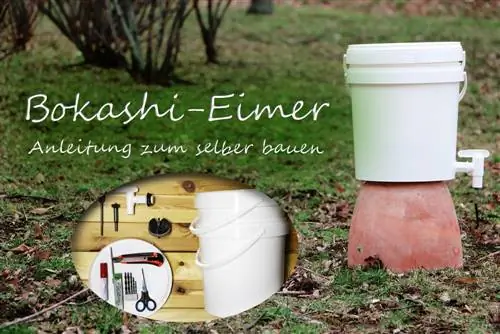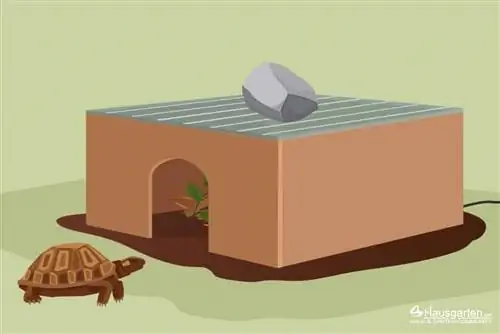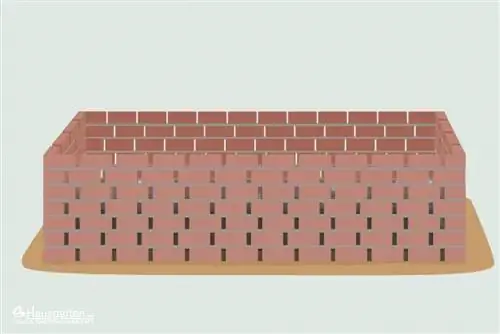- Author admin [email protected].
- Public 2023-12-17 03:39.
- Last modified 2025-01-24 12:45.
In addition to vermicompost, there is an even quicker way to obtain good, cheap fertilizer. We show how easy it is to build your own Bokashi bucket. With this technique from Japan you can quickly obtain fertilizer on the balcony or even in the apartment. The principle of a Bokashi bucket comes from Japan and uses lactic acid fermentation in the absence of oxygen. This means you can quickly obtain inexpensive fertilizer in a small space with minimal odor development.
Bokashi Bucket: Variant 1
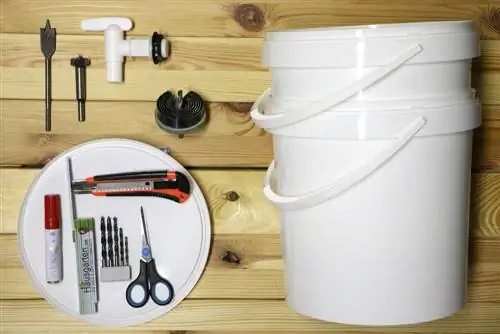
This variant is the most practical and easiest way to have your own Bokashi bucket. Implemented quickly and without much effort.
Material
- 2 identical conical buckets (plastic)
- 1 matching lid
- 1 faucet (rain barrel)
- if applicable some sealing tape
- 1 thin garbage bag
- 1 freezer bag filled with sand (quartz sand)
Tool
- Cordless screwdriver or drill
- Drill bit (universal or wood)
- Hole saw or Forstner drill
- Pen (waterproof)
- Ruler, ruler or similar
- Scissors or cutter knife
Drilling holes
Drill holes (only!) in the bottom of the inner bucket (B). The holes should be large enough so that any liquid that forms can easily drain downwards, but still small enough so that no organic waste falls through. Distribute the number of holes evenly.
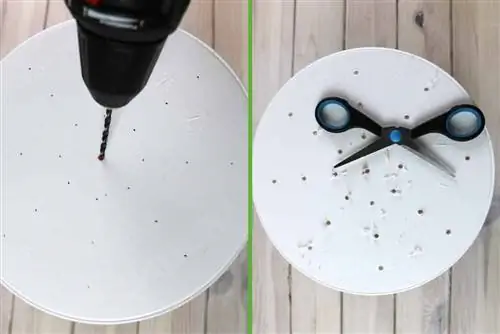
Tip:
Start with smaller and fewer holes. The number and size of the holes can also be increased the next time you clean if liquid builds up and doesn't drain properly.
Closing
The two buckets are now inserted into each other (the one with the holes goes on the inside). As soon as the lid is on the bucket, you actually have a finished Bokashi bucket. If the buckets don't fit together very well or you have the feeling that air is being drawn in, you can also seal the gap between the buckets with plasticine. Silicone is not recommended as it has to be removed every time you clean it and then reapplied later.
Tip:
However, it is advisable to install a drain in order to regularly drain the Bokashi liquid without always having to remove the inner bucket.
Drain
Place both buckets together and hold them in front of a light source (lamp or sun). Now you can see how much space there is on the floor between the two buckets. Mark this with a pen and measure the distance. Now you can buy a suitable faucet. It is important that the screw cap for the inside (the widest part of the faucet) fits within this distance.
If you already have a faucet that is a little larger, it won't be a problem. If the second bucket no longer fits completely into the outside, you can also cut a piece out of the inside. Place the screw cap on the outer bucket (A) and mark the center. A hole is now drilled into the bucket using a Forstner bit, hole drill or similar tool. It also works with scissors or a cutter knife, but is more dangerous for your fingers -so be careful!
Tip:
Hold a piece of wood against it from the inside to prevent the bucket from breaking or cracking.
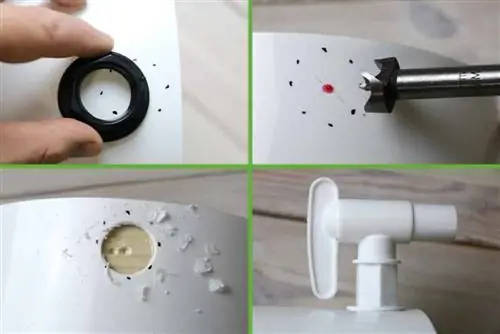
Once the hole has been drilled, the edge is carefully deburred with a cutter or scissors. Now you can screw the tap into the hole. If the hole is a little too big, you can seal it with sealing tape.
Bokashi Bucket: Variant 2
You don't always have two identical buckets available or you don't want to buy extra material. For this variant, a lockable bucket and a second one that can also be a little smaller are sufficient. The bottom of the inner bucket should be provided with holes as in variant 1. To create a cavity between the two buckets in which the Bokashi liquid fertilizer can collect, you should place a raised area in the large bucket. Flat plastic baskets or coasters made of clay or ceramic are suitable for this. Since the entire Bokashi principle is based on the exclusion of oxygen, the main thing is that the bucket closes tightly.
Fill correctly
Kitchen waste goes into a bokashi bucket, just as it would go into the compost. Vegetable or fruit waste and plant parts are perfect for this and are best chopped up beforehand.
Attention:
Meat (including fish), ashes or paper have no place in a bokashi bucket.
Activate
In order to activate or support the fermentation process, effective microorganisms “EM” must be added to the waste.
What are “EM”?
Effective microorganisms can be bought ready-made. It is particularly easy to dose as a spray. EM consists, among other things, of lactic acid bacteria, yeast fungi and many other very active little helpers. If you are particularly keen to experiment, you can also try your luck with unpasteurized sauerkraut juice, bread drink, sourdough, unpasteurized whey or the liquid from drained yogurt. There are reports that these things have a very similar effect - with no guarantee.
What else needs to go in?
Stone flourprevents the formation of odors, but please use it sparingly. Ceramic powder (2-3 teaspoons) and activated carbon support fermentation and also help with decomposition.
Sealing
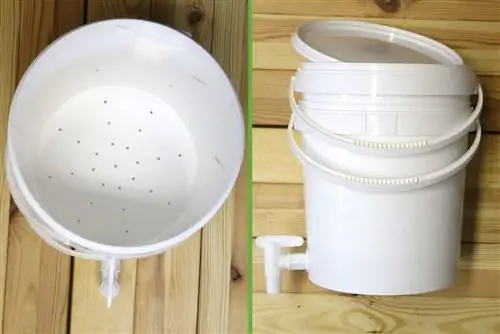
Once the organic waste and all other ingredients are in the bucket, the whole thing is covered with a garbage bag and compacted with a little pressure. There should be no voids between the waste because mold could develop here (which should be avoided at all costs). To ensure that nothing slips, a weight is added to the film. A larger freezer bag filled with quartz sand is ideal here. This now presses everything together and helps with sealing.
Bokashi Harvest
Every few days (1-3 days or depending on the level) you can drain the compost water and use it later as liquid fertilizer. The collected compost water is very acidic (pH value below 4) and should only be used as fertilizer when diluted with water. Depending on the plant, application and Bokashi mixture between 1:20 and 1:100. The guideline is 1:50, but you should be prepared to experiment.
Tip:
Make sure to always drain the liquid. The liquid must not rise into the other bucket - otherwise there is a risk of mold.
The actual Bokashi
The upper contents (Bokashi) can be disposed of in the compost after 2 weeks. Leave it on the compost for a few days and let it air out well. You can then mix it with other materials (green waste, etc.).
Alternatively, you can also soil the fermented Bokashi (mix well 1:3 with soil) and then add it to the bed as fertilizer. Since the Bokashi solids also have a very low pH value (are acidic), you should only use it in places and plants that can tolerate it. The very high nitrogen content promotes plant growth very well, but is too high for many soil inhabitants.
Note:
Never put finished bokashi directly into the worm composter.

